If you’re in the market for a sustainable, non-toxic rainboot for the little ones in your family, you’ve come to the right place. Here are our top picks for eco-friendly rainboots, plus some things to consider as you research brands.
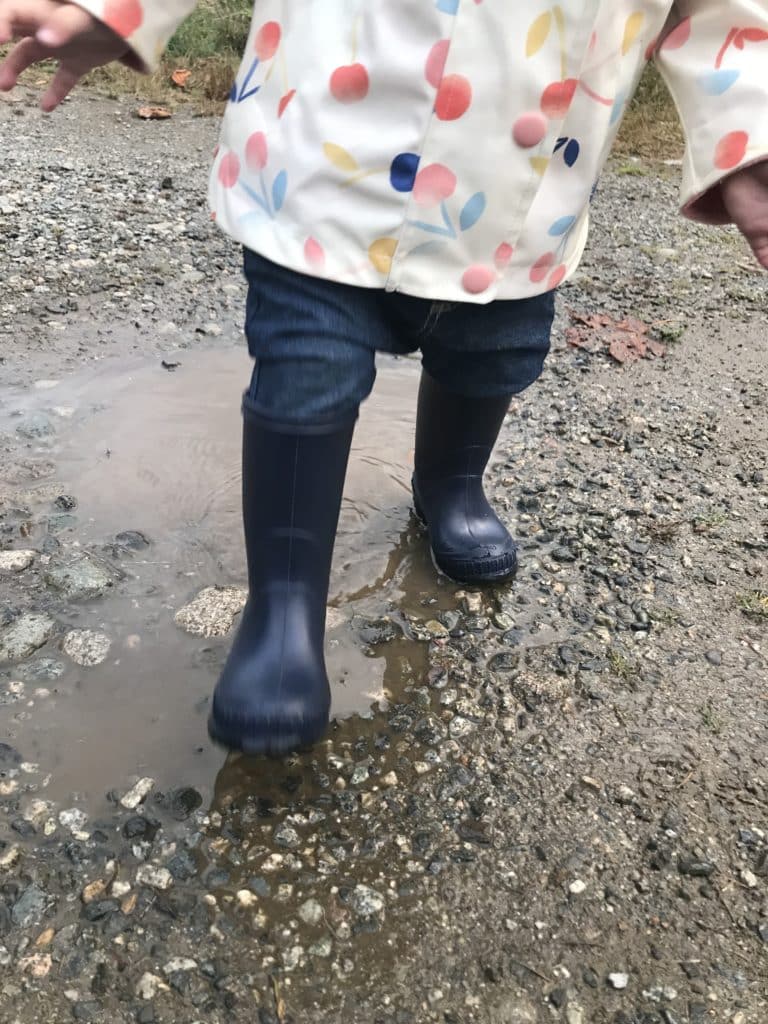
I live in the Pacific Northwest, in a rainforest, and my tiny toddler started toddling at 11 months. As such, I’ve spent many hours trying to track down sustainable rainboots for kids.
Most children’s rainboots are made with virgin plastic or synthetic rubber and are such poor quality that they crack and fall apart before you get a chance to pass them on to another kid. This is totally unsustainable and worrisome, given the increased absorption of chemicals like phthalates in moist, warm environments (like in a sweaty rainboot).
What to watch out for
- In some cases, plastic boots can cause skin blisters and rashes as the plastic irritates sensitive young skin.
- Synthetic boots are also liable to expose your kid to phthalates and other chemicals of concern, with some coated in forever chemicals (PFAS) for waterproofing and some posing a risk of lead exposure.
- In addition to being bad for kids, these synthetic boots are also bad for the environment. Most are made with virgin plastics and are not recyclable or durable. Instead, they quickly break and soon end up in landfill. This is a huge waste of money and resources and can pollute the soil and waterways.
Look for PVC free boots:
If you can stretch your budget to a new pair or can find a good pair of natural rubber boots second hand (or a quality pair of recycled PVC-free boots), your wallet will thank you long-term. Chances are, by buying a durable, quality pair of kids rainboots now, you can reuse these or sell them down the line.
They will also be much better for your kids’ growing feet and for the planet they hope to live on for decades to come.
Neoprene isn’t sustainable
A lot of kids’ boots are made with a synthetic rubber sole and neoprene sides or top tabs to make it easier to put the boots on. What is neoprene, though, and is it sustainable?
Neoprene was one of the first synthetic rubber products invented. It was created in 1930 by DuPont and is generally harder and stronger than natural latex while also being more water-resistant and resistant to oils and solvents. Neoprene is a popular material for wetsuits, protective equipment, and in flexible rainboot uppers and cycling overshoes.
Neoprene is largely inert, posing little, if any, health risk to end users. The production of neoprene involves chloroprene, however, which can be a workplace hazard if proper protective equipment isn’t used.
Neoprene is also a petroleum product, meaning it is not natural. Neoprene does not easily biodegrade, taking up to 100 years to break down in landfill. It is also difficult to recycle, making it extremely unsustainable compared to natural rubber and many other materials.
Free eBook: Simple Steps to a Greener Home
Concerned about climate change? Learn actionable tips for making each room in your home greener.
"*" indicates required fields
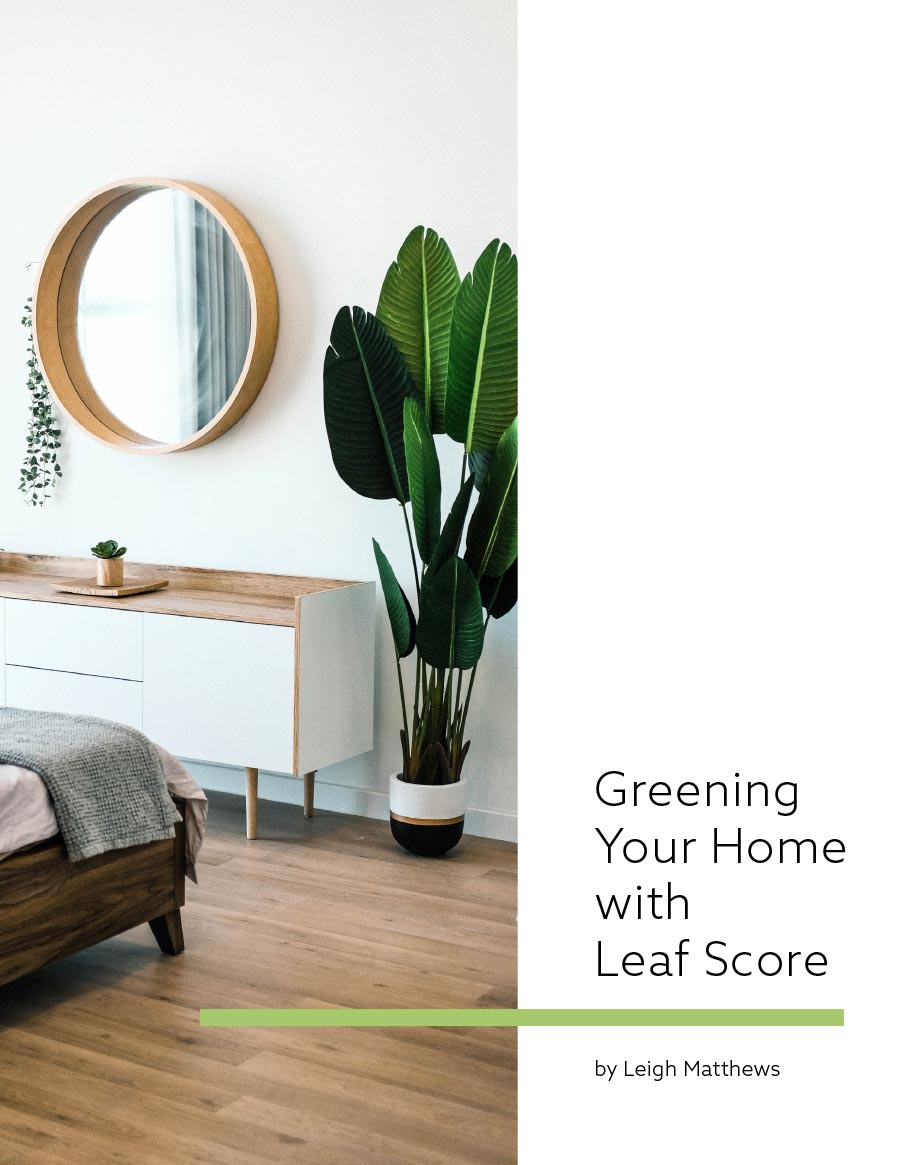
Take the time to find PFAS free Rain boots
Kids rainboots should absolutely be free of PFAS and other harmful chemicals. This means looking for certifications such as OEKO-Tex, REACH, or Prop 65.
If you’re buying boots that the company claims are made with recycled materials, look for certification by the Global Recycling Standard (GRS). You might also look for certifications that suggest the company engages in ethical manufacturing practices, such as only using factories that pay fair wages and have safe working conditions with no forced labor or child labor.
This means looking for companies that are Fair Trade, B Corporations, or use factories that are signed up to the Worldwide Responsible Accredited Production (WRAP) or Business for Social Compliance Initiative (BSCI).
Better yet, look for companies that meet all these standards and donate shoes and boots to kids in need (like Roma)!
Our top picks
Here are my top picks for the best sustainable rain boots for kids, made (mostly) with natural or recycled materials and free of phthalates and other nasty chemicals we definitely want to keep away from tiny toes.
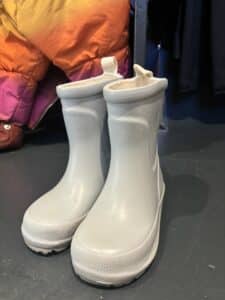
Gray Label
Highlight: FSC-certified natural rubber kids rainboots with GOTS certified organic cotton linings, made in Europe by a super sustainable company.
Gray Label is the real deal for sustainable kids boots (and clothing and apparel for babies, kids, and adults). The Danish company makes its boots in Slovakia using FSC-certified natural rubber and GOTS certified organic cotton linings.
These rainboots are available in a low and regular height and start at sizes 21 and up in the low and 24 and up in the regular. However, sizes 21 to 24 are currently out of stock (you can subscribe for alerts for when stock is back).
The main downside to these boots is a limited choice of colors, all of which are very subdued. Don’t expect the same bold, bright colors and patterns usually seen in rainboots for children. If rose gold, pale purple, plain black, and subtle blue-gray are more your jam, these are definitely worth a look.
Why we like Gray Label
The boots are packaged using recycled, plastic-free materials, and despite being significantly more sustainable than other brands, Gray Label boots are about the same price!
Other things we like about Gray Label include the company’s rental program. This is designed for babies and toddlers up to two years old and is a great way to cut down on consumption and resource use in those early years. We ordered a test pair of Gray Label boots for a team member who lives in Jackson, WY. The package arrived plastic free as promised and the boots have performed well in mud season, which is the time of year that it’s either raining, or snow is melting. We picked a gender neutral color which makes the boots easy to pass down to siblings.
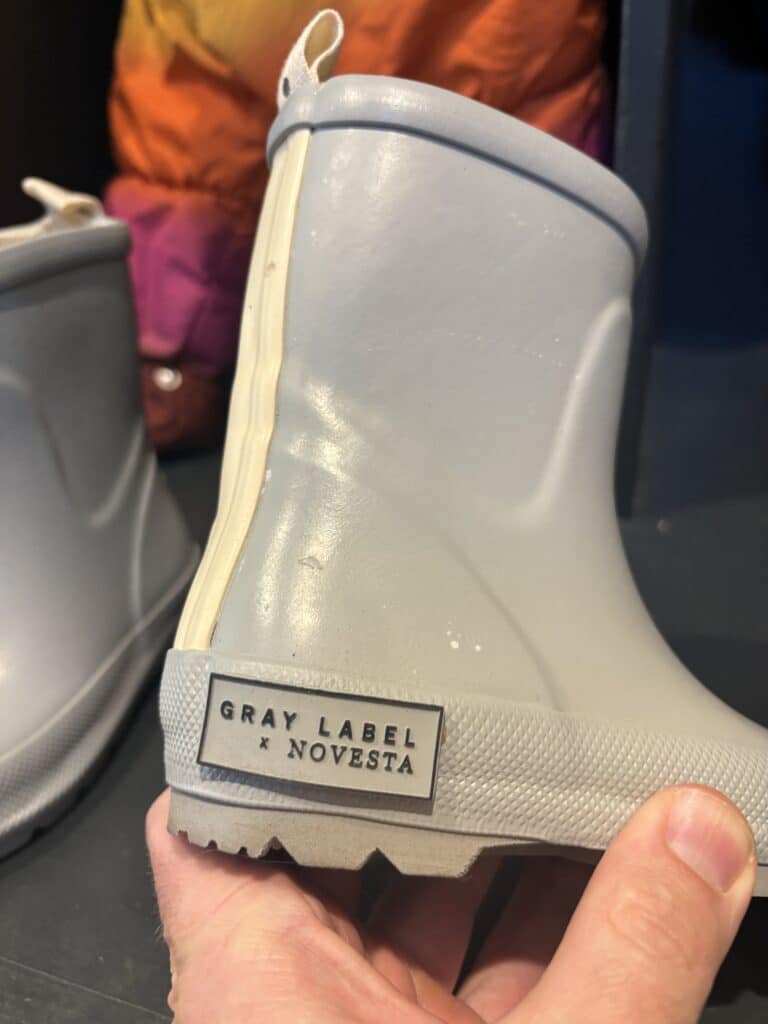
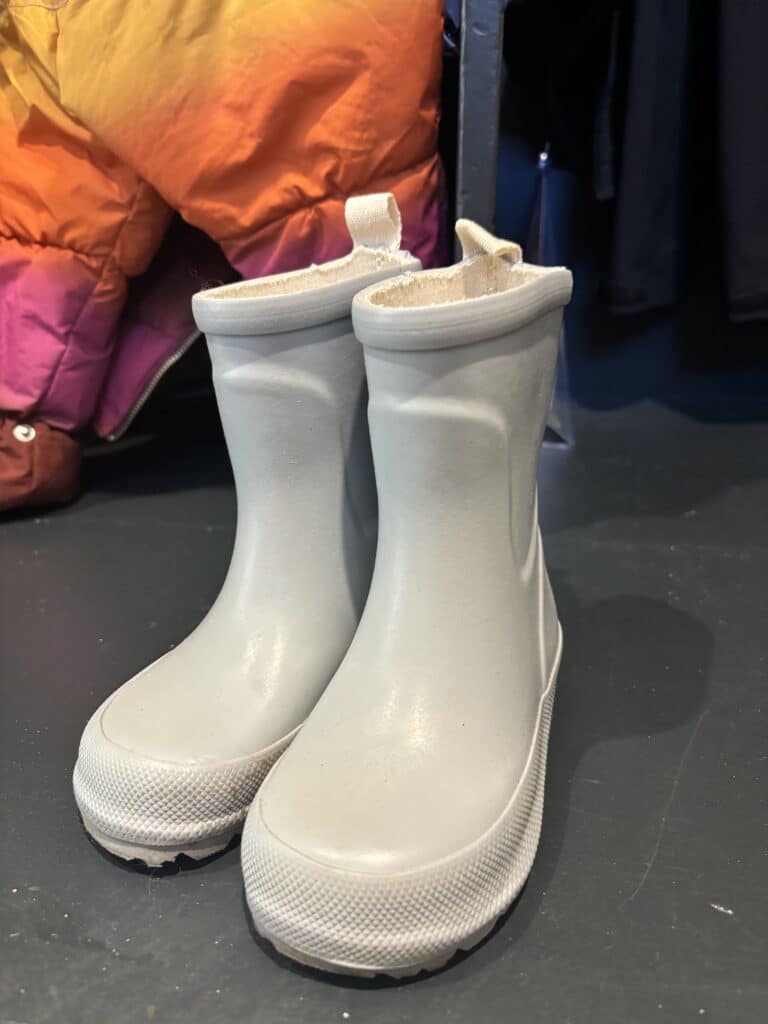
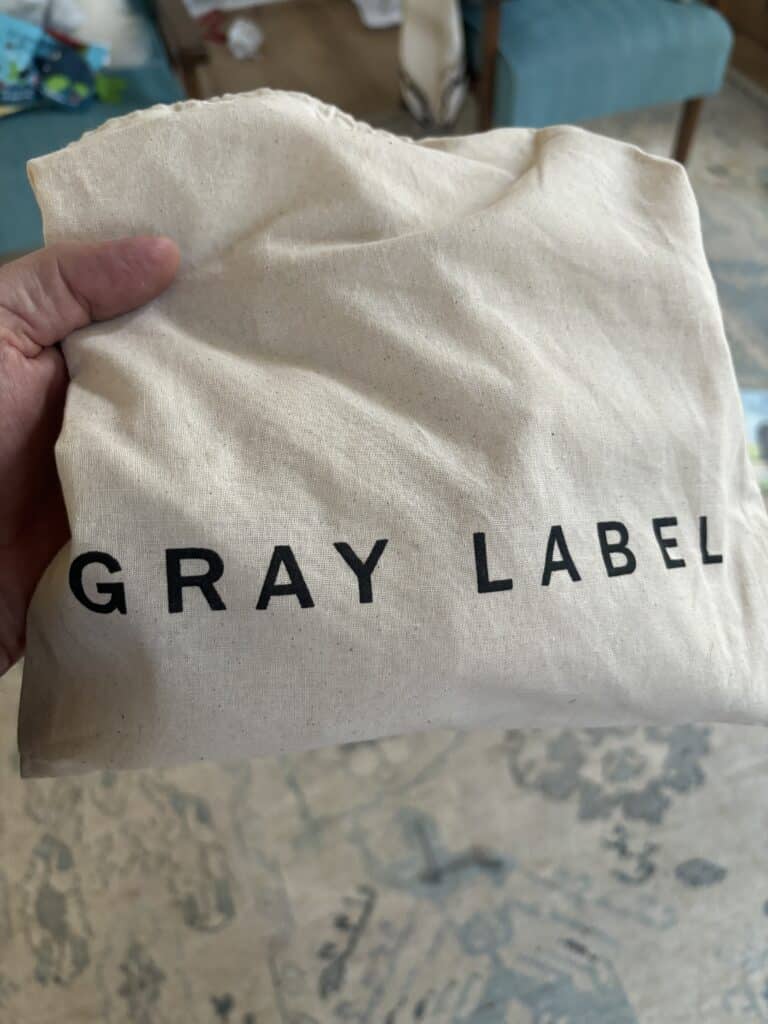
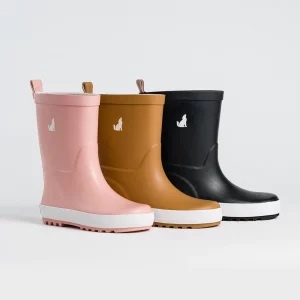
Crywolf
Highlight: Flexible, lightweight, gorgeous rubber boots for kids, made with FSC-certified natural rubber and cotton linings. Hardwearing and fast-selling. Get them while you can!
Highlight: Flexible, lightweight, gorgeous rubber boots for kids, made with FSC-certified natural rubber and cotton linings. Hardwearing and fast-selling. Get them while you can!
Crywolf is a New Zealand company making natural rubber rainboots for toddlers and beyond. These attractive boots are available in a variety of matte colors with cotton liners and are very well made. The boots come in a unique Crywolf carry box made with sustainable packaging materials.
Crywolf boots now feature reinforced panels to make them even more hardwearing. They have a heel pull tag and a high-grip tread and are clearly designed to be functional in rugged outdoor conditions, rather than just splashing in a puddle or two. The minimalist design is very subtle but there is a white wolf logo on the side.
Why we like Crywolf
Crywolf boots are independently tested for quality and waterproofing by Intertek. The boots are designed and tested in New Zealand and manufactured using FSC-certified sustainably sourced rubber. Manufacturing takes place in China under fair working conditions at small family-run factories with ethical accreditations and regular auditing.
The company is relatively new but already has a dedicated following and often sells out because Crywolf tries to avoid overruns and waste by limiting production runs.
Crywolf rainboots are available in sizes US 4 (EU 20, 13.4 cm insole) to US 2 (EU 33, 22 cm insole). The boots measure 15 cm high for the smaller sizes, 18 cm high for sizes 7.5 to 10, and 20 cm high for sizes 11 through 2.
Crywolf also makes really cool children’s rain jackets and rain overalls using recycled water bottle insulation and other eco-friendly materials like GOTS certified organic cotton, Repreve® recycled polyester, recycled PET polyester, and fluorine-free Bionic Finish® Eco waterproofing solutions.
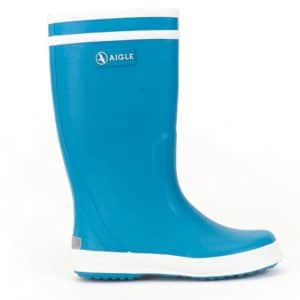
Aigle
Highlight: Longstanding European company making quality rainboots for toddlers, older kids, and adults. Available in sizes 3.5 and up, and made mostly with natural rubber by a more sustainable company. A great fit for tiny feet!
Aigle make the smallest, most sustainable toddler rainboots I’ve found yet. These adorable boots are made with a majority of natural rubber and most have a lining comprising 65% polyester and 35% cotton, a polyester insole, and a rubber outsole. There’s also a more sustainable version of the toddler rainboot (and bigger kids’ boot) with a recycled polyester and cotton lining.
Aigle has been making these toddler rainboots for four decades and has been in business since 1853. The durable design is perfect for pulling on over chubby toddler calves. The distinctive boots come in sizes ranging from 3.5 US (13.5 cm long, 19 UK) to 6.5 US (15.5 cm long).
Aigle also makes boots for bigger kids and adults. There are tons of color options and even some patterned boots. Most boots are printed single colors with the signature white Aigle double white strip at the top and white stripe sole.
These more sustainable toddler rainboots have a reflective strip on the heel and a flexible upper. Because these rainboots are made with natural rubber, it’s best to keep them away from heat or light when not in use and to store them upright. To keep them in good condition, give them a rinse after each use (if they’re exposed to salt water or are dirty), clean with neutral pH soap, and wipe with a lint-free cloth.
Aigle also offers a Multibloom printed version of the classic children’s rainboot (view here) with a recycled polyester and cotton lining and mainly natural rubber exterior.
Why we like Aigle
Aigle manufactures these toddler rainboots in China under fair working conditions. The company is transparent about its suppliers and manufacturers and works with suppliers who comply with the ICS charter. This ensures fair wages and working hours, zero tolerance for child labor or forced labor, and no discrimination.
Aigle is also a signatory to the UN Global Compact on Human Rights, which focuses on labor standards, anti-corruption, and protecting the environment. It is also working towards more sustainable sourcing of materials and social audits of all its products and in 2020 became a ‘purpose-driven’ company. This kind of company is subject to the PACTE Law in Europe and enables a commercial company to integrate social and environmental objectives into its statutes. The program requires a company to establish a Purpose Committee, responsible for regularly verifying whether the company’s management decisions are consistent with its purpose. In this case, Aigle’s purpose is to become more sustainable and to leave nothing but footprints.
To this end, the Aigle Spring/Summer 2022 ‘Explore‘ collection was made with 100% recycled polyester paddings and 91% of the collection was PFC Free. The Aigle Fall/Winter 2022 collection is even more sustainable, with the company aiming for 100% of products to be sustainable by 2028.
To achieve its goals, Aigle plans to implement I:CO collection boxes in 50% of its stores by the end of 2022 and to hold more in-store repair workshops, while also promoting its second-hand platform, Second Souffle. It also has a target of reducing its carbon footpring by 46% by 2030.
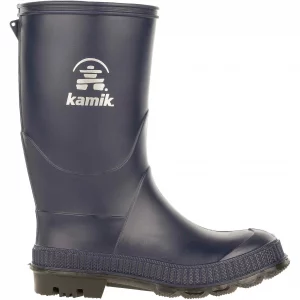
Kamik Toddler Rainboots
Highlight: Top quality rubber boots made in North America with recycled materials and fully recyclable! Extremely durable and available from 3T up, making for great hand-me-downs!
Kamik’s kid’s rainboots are on the pricier side but are an absolute bargain if you plan to have more than one child. They also really hold their value for resale as these boots are extremely durable.
Kid sizes at Kamik start at 3T up to 7 Y, meaning they work even for smaller footed early walkers.
Kamik’s rain boots are 100% waterproof and are made with durable vulcanized rubber. They’re PVC-free, easy to pull on, and relatively light for rubber boots. They have a removable EVA footbed for cushioning, but you can remove this for fast drying and a little extra wiggle room with thick socks. These rain boots also have a reflective binding or patch for safety.
Why we like Kamik
There’s a lot to love about Kamik, aside from the durability of these boots. The company has a strong commitment to greener manufacturing in North America and an impressive rain boot recycling program for instance. That means, once your rain boots finally stop being usable, or if they suffer an extreme accident, you can send them to Kamik to have them turned into something new. The company even offers prepaid shipping labels if you email them.
Kamik’s Canadian-made winter boot liners comprise 100% recycled felt made with plastic from water bottles. The company also recycles 90% of the cooling water used in its Canadian factory, and some 360,000 black rain boots are produced every year in its North American factories using recycled rubber.
All of Kamik’s rain boots made in North America are 100% recyclable, demonstrating how the company understands the importance of a circular economy for a reduced environmental footprint. There’s no PVC in any of its products and everything is shipped in recycled and recyclable packaging.
The downsides to Kamik are that the company also uses leather and suede, albeit from slightly more eco-friendly suppliers than most shoemakers. And, naturally, we’d love to see a natural rubber rain boot from the company, in addition to recycled synthetic rubber.
We received a pair of size 4 hand-me-down Kamik rainboots that look pristine but have been used by five toddlers! These boots were super easy to put on my toddler and will probably fit okay with an extra pair of socks in a month or two. For now, though, we’re rocking size 2 or 3 shoes most days, so these fall off quite easily. All that to say, they fit true to size!
One thing to note, though, is that compared to some other kids boots, the Kamiks are quite tall (17 cm). This makes them thigh-high on my toddler, which made standing up independently and climbing stairs more of a challenge than it need be. Once upright, my toddler quickly figured out how to walk in the oversized boots and demanded to go outside. I can see us having a lot of fun in these boots in a couple of months and am so happy that they’re durable but flexible, 100% waterproof, and now tried and tested at keeping the rain away from tiny toes that have just discovered the joy of puddle-jumping.
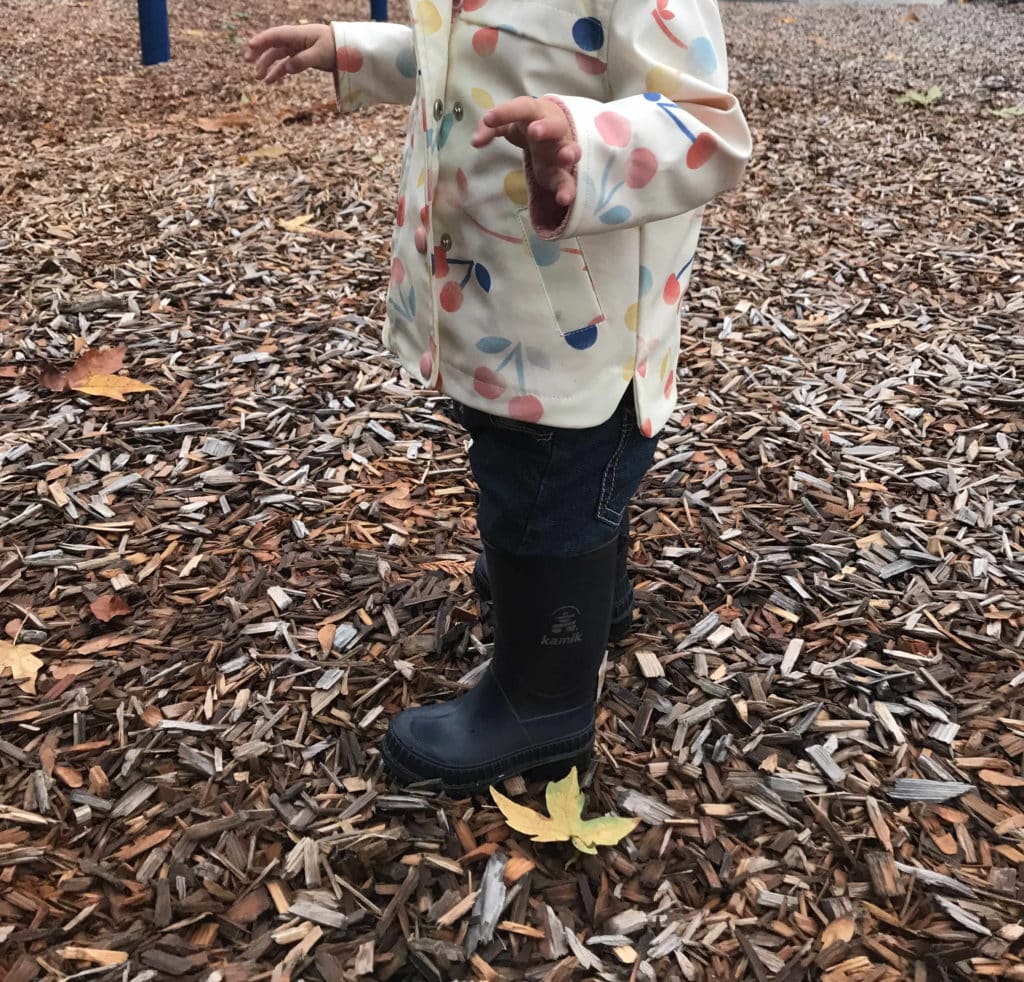
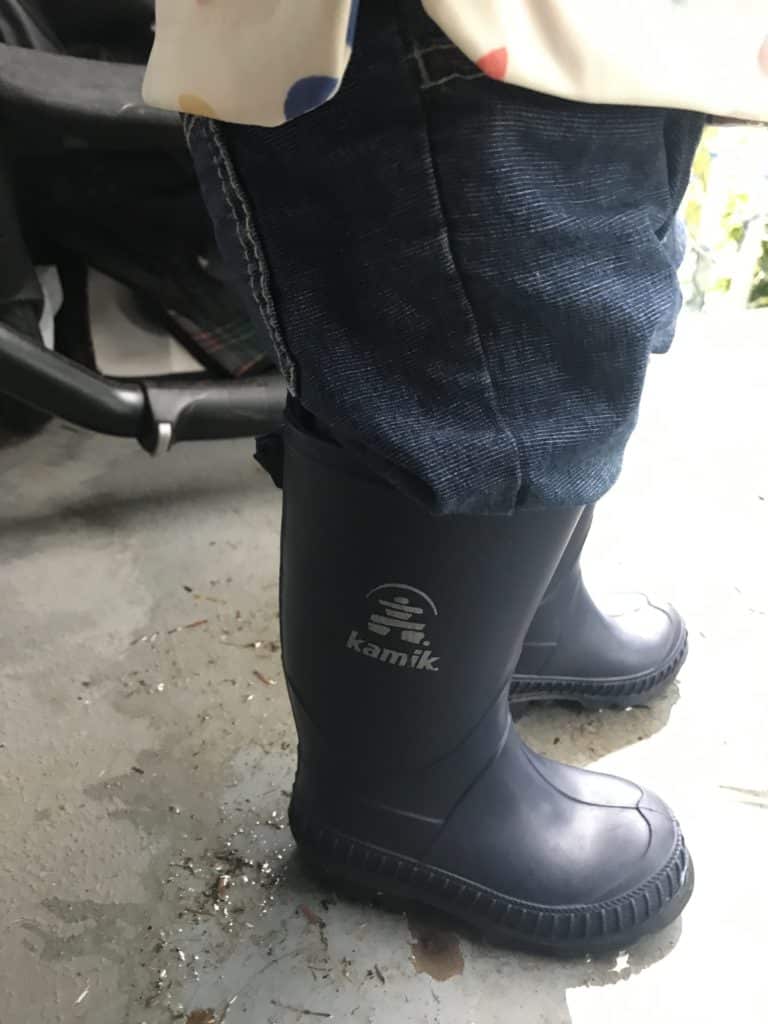

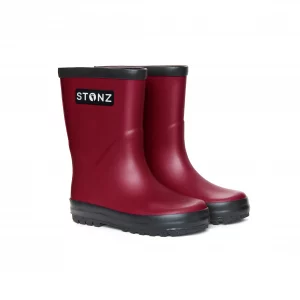
Stonz Rubber Boots
Highlight: Natural rubber boots that are durable, flexible, and free from a variety of unpleasant chemicals.
Stonz is a Canadian company making waterproof footwear for babies and kids. Their range of baby rainboots and booties works for infants and kids from 0-6 months up to around eight years old.
Classic Stonz Rainboots are made with a good amount of natural rubber and have a 35% cotton and 65% polyethylene liner. The Stonz rainboots are free from lead, phthalates, PVC, flame retardants, and cadmium, and the glue used to stick them together is formaldehyde-free. The boots don’t off-gas and are safe for bare skin, though it’s still best to wear socks while wearing these boots. Stonz also offers rainboot liners for sizes 4T and up, though these are made with 100% polyester.
These partly natural rubber boots are comfortable, flexible, and made of thick, durable rubber. Unlike cheap totally synthetic rubber boots, these boots can withstand bending, so your little one can jump, splash, and crouch down without the rubber cracking and their feet getting soaked. The rubber soles are non-slip too and offer decent traction in slippery, snowy conditions.
Natural rubber also offers a bit more bounce than synthetic rubber, making these boots better for developing feet. Stonz footwear carries podiatric certification from the Canadian Podiatric Medical Association (CPMA) and the American Podiatric Medical Association (APMA) for supporting healthy, developing feet.
Stonz Rainboots are available in eight colors and in sizes from 4T to 2Y. Because they’re made with a lot of natural rubber it’s best to store these boots in a cool, dry, shaded location and to rinse them if exposed to salt from the ocean or roads.
What are Stonz boots made of?
These Stonz boots are made with 45% natural rubber and 55% other rubber content. That other content includes ZnO, C18H36O2, rubber Anti-aging agent, carbon black, CaCO₃, and accelerator promoter. For the most part, these materials don’t pose a safety risk and are natural.
ZnO, CaCO₃, and C18H36O2 are zinc oxide, calcium carbonate, and stearic acid, respectively. These substances are not synthetic and don’t have adverse health effects as used in this product.
Carbon black is a byproduct of petroleum combustion and is classed as a potential carcinogen but is generally considered safe as part of a final product such as in car tires or rubber boots.
Rubber anti-aging agents and accelerator promoters can include a variety of chemicals, some of which may be toxic. I’ve asked Stonz for more information on these materials and am waiting to hear back.
Stonz also offers Scout and Trek winter boots for colder days, with the boots rated down to -58ºF/ -50ºC. These boots contain quite a few synthetic materials, though, so stick to the more natural rubber rainboots and use thick wool socks or eco-friendly boot liners to keep feet warm and cozy.
Stonz also makes baby and toddler booties that work well for wet fall and spring days and puffer booties for cold winter days, though, again, these are made with synthetic materials.
Why we like Stonz
Stonz considers itself an eco-friendly company. Given that the company still uses a lot of virgin synthetic materials in its products, this seems largely related to the idea that the kids’ footwear is designed to be longlasting and with built-in extenders, allowing for longer use by kids as they grow and for use by successive kids.
That said, Kamik has a similar ethos of making rain boots that are sustainable by way of their durability, and it does this with entirely recycled materials that are themselves recyclable.
In the absence of any rigid rainboots to fit our tiny toddler, we picked up some Stonz Booties to go over regular shoes. These make our kid look like an astronaut but don’t seem to inhibit walking and have made the fall rain less of a challenge for our outdoorsy toddler.
The nice thing about these booties is that they can be used with or without other shoes. They’re not 100% waterproof, especially because when cinched in, water pools in the folds on top of the foot. They are water resistant enough, though, for a rainy walk as long as you have a spare pair of socks to change into. I wouldn’t want to use these in the rain once it gets colder though.
Also, when used for smaller feet, the toggles are long enough to get tangled and be a tripping hazard. For most toddlers with adorably chubby feet, this is unlikely to be a problem.
If you’re also struggling to find kids’ shoes that fit, whether because your kid has tiny feet, giant feet, chubby feet, or slender feet, Stonz are a really solid option. They’re designed to let growing feet grow and learning feet learn. The outer sole is made with grippy SlipNOT material and the inside is slightly fleecy, making these gentler on the skin than many rubber boots made with hard, synthetic plastic.
Sure, they’re synthetic, but Stonz Booties seem to be very durable and made with largely inert materials that don’t have adverse health effects. They are also overboots, meaning minimal, if any, skin contact. In a world where tiny rainboots just don’t seem available, this was the best option we found.
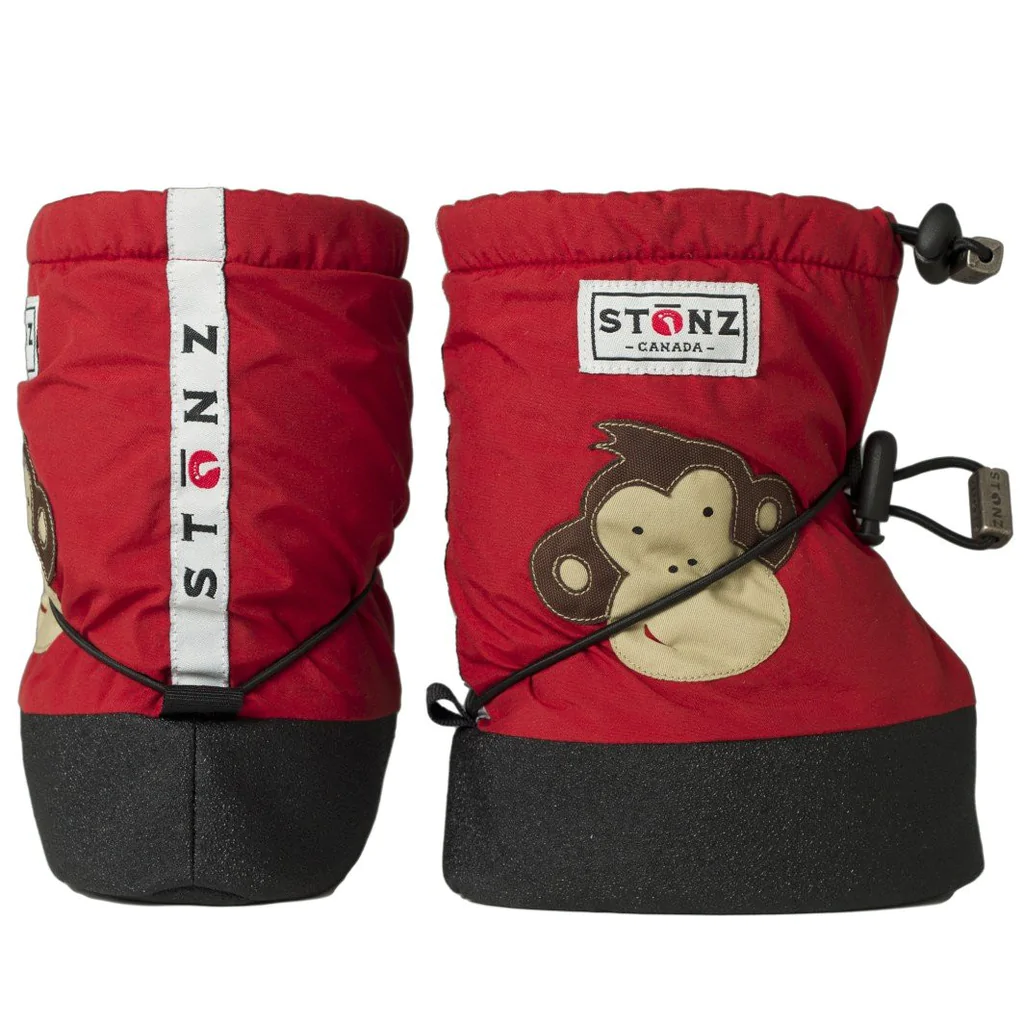
More companies to consider for toddler rainboots
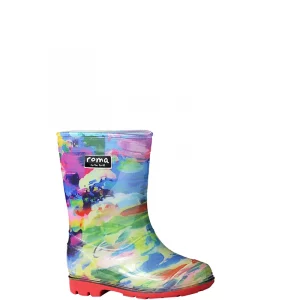
Roma
Highlight: Vegan, natural rubber gumboots with cotton linings from a company that donates rainboots to kids in need. Some boots have PVC soles, however.
Roma makes natural rubber rainboots for kids and adults in sizes starting from a US 7 toddler. For each boot sold, Roma donates a pair of new rain boots to a child living in poverty. So far, the company has donated an estimated 100,000 boots to kids in 27 countries.
Roma’s boots are all vegan, made from natural rubber with a cotton lining and multi-layer cushioned insole (read: synthetic foam). Some boots also have a PVC sole. The boots are made in China under fair labor conditions and are shipped worldwide.
Roma also makes boots for adults from PVC, so check product listings carefully if you’re shopping for your kid and get tempted by boots for yourself!
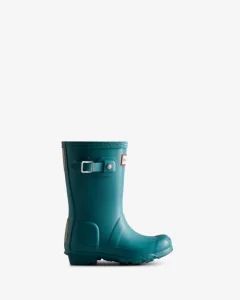
Hunter Kids’ Rainboots
Highlight: A wide range of kids’ gumboots made with natural rubber and, in some cases, recycled materials – anti-slip sole, handcrafted, certified vegan, and 100% waterproof.
Hunter offers a wide range of kids gumboots made with natural rubber and, in some cases, recycled materials (check individual product listings). The boots all have an anti-slip sole, and are handcrafted, certified vegan, and 100% waterproof.
These sustainable kids rainboots include a starcloud range with built-in glitter and a nebula range that shimmers. There are classic Hunter solid colors and a range of rainbows and other prints.
The Hunter kids boots start at a US 5 (EU 21, 14 cm insole) and go up to a US size 2 (EU 33, 21.3 cm insole). This makes them suitable for most kids aged 2-6, though the Hunter Kids First range is intended for toddlers 18 months and up as these have a flatter sole (no heel) and rounder toe.
Some of the boots have a soft cotton lining, some have a virgin polyester microfleece lining, and some have a lining and insole made with 100% post-consumer recycled polyester. Some of the boots also have grab handles to help little hands pull on little boots.
Hunter offers a 2-year warranty on boots.
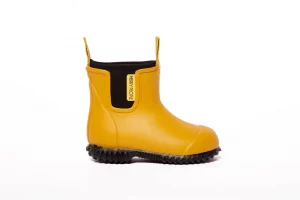
Merry People is an Australian company that makes vegan rainboots for kids and adults. The kids Bobbi gumboots are available in sizes from US 5 and mostly comprise natural rubber, though they also have a neoprene lining.
There are six fun color options, and these are a Chelsea-style, low gumboot with handles for easy on and off.
Merry People has only been around since 2014 but already has a dedicated following. The company donates to environmental and social justice charities and while the boots are made in China, the company ensures fair working conditions and labor practices.
All Merry People boots come with a 12-month workmanship warranty.
A quick note on sizing for toddler rainboots
Our toddler is on the smaller side, barely fitting a size 2 for those precious first steps. This made it a nightmare to find rainboots that fit and are actually waterproof and robust enough to walk in.
Shoes this size tend to be designed as decorative accessories for a babe in arms, which does little to protect our all-terrain toddler’s feet during forest scrambles, puddle jumping, or when clambering over logs at the beach.
In fact, most rainboots start at a size 4, which is confusing when you may also see sizes 1, 2, and 3 listed for a product.
If you’re learning all about the weird world of kids’ shoes for the first time, the inside scoop is that sizes start at 0 for infants and go up to 13, usually with a C or T after the numbers, at least in the U.S. After that, they start at 1 again, sometimes with a Y for youth.
While I wait for the tot to stretch into a size 4, my workaround is to use the Stonz booties, acquired secondhand, as overboots for soggier days. At first, we just used the Stonz by themselves, as it’s far better for early walkers to have soft-soled shoes rather than stiff soles. Now, though, we use a pair of soft shoes inside just for a bit of extra support.